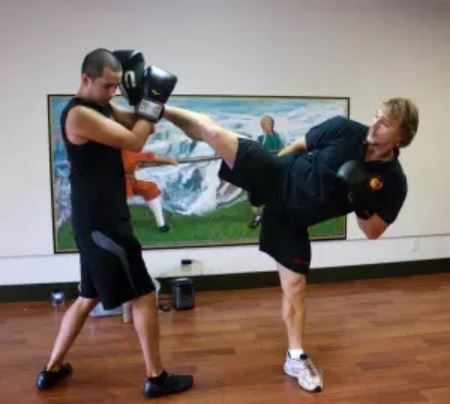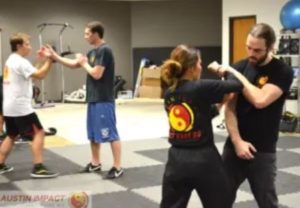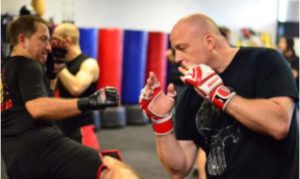“The on-guard position is that position most favorable to the mechanical execution of all the total techniques and skills. It allows complete relaxation yet, at the same time, gives a muscle tonus most favorable to quick reaction time.”–Bruce Lee (Tao pg. 29)
Fighting stance is key in any martial art and can largely determine how you will fight. Look at the difference between how a wrestler and a Muay Thai Kickboxer stand.
A wrestler squats down low in order to maintain a low center of gravity. His hips are back, giving him a head start on avoiding getting taken down and also to help him explode forward for a takedown of his own.
On the other hand, a Thai Boxer traditionally stands almost straight up with his feet closer together in case he needs to quickly hike a knee up to block a kick. His weight may be mostly on his back leg, allowing him to use quick lead leg kicks to his opponent’s body or to throw his weight forward into his rear leg kicks, adding tremendous power.
Each of their stances largely determine what they can and can’t do. Can you imagine our wrestler trying to check a leg kick by lifting his leg from such a low stance? Or our Thai Boxer shooting in for a double leg takedown? It’s unlikely.
So although I am going to share with you the “by-the-book” JKD On Guard Position, it’s important that you understand first of all why Bruce Lee chose that as the best position for him, and second that you allow yourself to make adjustments according to your own strengths and weaknesses. Ultimately, the On Guard Position should be your own.
So here we go:
Feet shoulder width apart for stability.
Right foot in front (if you are right handed this puts your strong side forward. Remember, you’re not training to go rounds with an opponent. The fight should be over as quickly as possible and putting your strong side forward allows you to tear a guy up with the closest tools to your target while at the same time remaining well covered and balanced).
The lead foot is turned in slightly. One reason for this is that your knee helps to protect your groin from a foot coming straight up.
The rear foot is turned in just past 45 degrees. You want a slight tension in your leg for explosiveness. If you were to push directly off your back foot your hip would drive you forward rather than to your right side.
Your back heel is up, coiled and ready to fire. Think of it like a spring. There are 3 reasons for having it up: (1) It allows you to shift your weight quickly and easily, giving you lighter, faster mobility, (2) You’ll explode forward quicker, allowing you to transfer more speed and power into your strikes, as well as having more drive in your punch, and (3) It acts as a shock absorber if you get hit. There’s some “give” so that some of the force of the blow is dissipated.
Your knees are bent comfortably. Among other things, this allows for a greater “thrust” in your punches as well as better balance and “groundedness”.
Your weight should be evenly distributed, 50/50, over each leg. This allows you to move in any direction quickly.
The body is turned about 45 degrees. This takes your body off line so that you’re not an easy target and also allows you to put your hip into both your lead hand and your rear hand.
Maintain a slight forward crouch.
Rear hand is up “on the telephone”–not the chin. In a street fight you won’t have big ol’ gloves protecting your head. So you want it up. Start by getting in the habit of placing it by the side of your head, although holding it anywhere around your face is just as good. It can be useful to hold it “cupped” in front of your chin to catch your opponent’s jabs, etc.
Lead hand has a lot more play. Having it up provides 2 barriers that your opponent has to get around to hit you, so it’s more defensive in nature. You can hold your hand on your centerline (in front of your nose), like looking down the sight of a gun, or high and to the side, giving you a more open guard. Having it down (as if you were pointing to the ground with your index finger) places it more in the periphery of your opponent, making it harder for him to keep track of. It also allows you to fire shots from all angles without any telegraphing motion (not winding it up or giving it away) and you can throw your hip into it more, making this position more offensive in nature. It also keeps your arm more relaxed so it doesn’t tire out as fast and the position can be used to draw your opponent’s attacks so you can counter.
Elbows are tucked in to protect the ribs and to make your punches straight.
Your chin is tucked down and your head is forward. You should be looking slightly up at your opponent. Think of your chin as the “off button”. If it gets hit you turn off. Not good. (Also, having the chin down actually flips a psychological switch in your brain that puts you in the role of Predator as opposed to Prey. Notice how a wild animal stalks its prey with its head tilted down. It’s in our biology and can be useful when dealing with the Fight or Flight response during an attack.)
Have an aliveness to your stance. The engine is “on”.
I know that’s a lot of nitpicking on just how to stand. But don’t worry. You’ll be in that stance so much during your training that it won’t be long before it’ll feel like home base.



